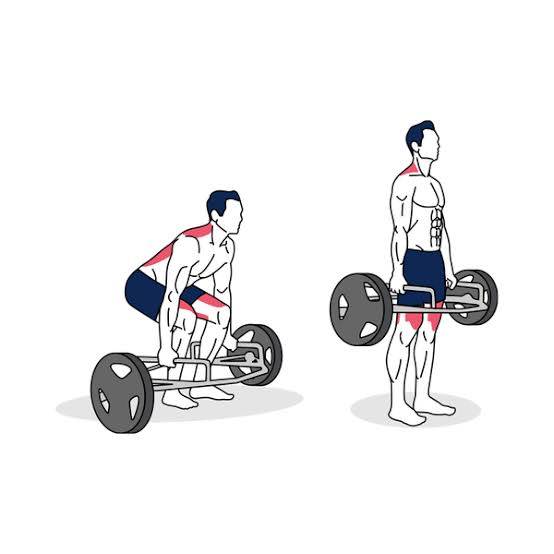The Science Behind Hex Bar [In Simple Words]

Hex bar training has gained popularity in recent years due to its unique design and the biomechanical advantages it offers. Also known as the trap bar, this piece of equipment is particularly favored for its ability to reduce lower back strain and provide a more natural lifting posture. This article delves into the scientific principles behind hex bar training and explores why it can be a valuable addition to your strength training regimen.
Understanding the Hex Bar
Hex Bar Design: The hex bar is a hexagon-shaped barbell that you step into, with handles on either side. The weight plates are loaded on the ends, and the handles allow for a neutral grip (palms facing each other). This design contrasts with the traditional straight barbell, where the weight is positioned in front or behind the body, depending on the lift.
Biomechanics of Hex Bar Training
Center of Gravity and Load Distribution
One of the key advantages of the hex bar is its impact on the center of gravity and load distribution. When lifting with a traditional barbell, especially during deadlifts, the weight is positioned in front of the body. This forward position requires greater engagement of the lower back and posterior chain to maintain proper form and balance.
With the hex bar, the weight is centered around the body, aligning more closely with the lifter’s center of gravity. This alignment results in several biomechanical benefits:
- Reduced Lower Back Strain: By centering the load, the hex bar reduces the shear forces on the lower back, making it a safer option for individuals with lower back issues or those new to lifting.
- Improved Balance and Stability: The centered load distribution enhances balance and stability, allowing for more controlled and efficient lifts.
- Enhanced Force Production: The alignment of the hex bar enables lifters to generate more force, as the body is in a more natural and powerful position to lift heavier loads.
Muscle Activation and Recruitment
Traditional Deadlift: In a traditional barbell deadlift, the primary muscles engaged are the glutes, hamstrings, lower back (erector spinae), and to a lesser extent, the quadriceps. The barbell deadlift is known for its ability to develop posterior chain strength and hypertrophy.
Hex Bar Deadlift: The hex bar deadlift, on the other hand, involves greater quadriceps activation due to the more upright torso position during the lift. Studies have shown that the hex bar deadlift produces similar, if not greater, levels of muscle activation in the quadriceps compared to the traditional deadlift. This makes the hex bar deadlift a more balanced lower body exercise, targeting both the anterior and posterior muscle groups effectively.
EMG Studies: Electromyography (EMG) studies have compared muscle activation patterns between hex bar and traditional barbell deadlifts. These studies generally indicate that while both exercises engage the glutes and hamstrings significantly, the hex bar deadlift elicits higher quadriceps activation and reduces the load on the lower back [source].
Range of Motion and Joint Stress
Range of Motion: The hex bar allows for a slightly different range of motion compared to the traditional barbell. The neutral grip and centered load enable a more natural hip and knee flexion, resulting in a lift that combines elements of both squatting and deadlifting. This hybrid movement pattern can be advantageous for overall lower body development.
Joint Stress: The neutral grip position of the hex bar reduces stress on the wrists and shoulders, making it a more joint-friendly option for lifters with pre-existing shoulder or wrist issues. The reduced lower back strain also means that the hex bar deadlift places less stress on the lumbar spine, which is a common area of injury in heavy lifting.
Performance and Strength Gains
Strength Gains: Research has shown that the hex bar deadlift can produce comparable, if not superior, strength gains in the lower body compared to the traditional deadlift. The ability to lift heavier loads with the hex bar, due to its ergonomic design and improved force production, contributes to significant strength improvements over time.
Power Output: The hex bar is also known for its potential to enhance power output. Studies have indicated that athletes can generate higher peak power and force during hex bar deadlifts compared to traditional barbell deadlifts. This makes the hex bar a valuable tool for athletes looking to improve their explosive power and athletic performance.
Practical Applications of Hex Bar Training
Rehabilitation and Injury Prevention: Due to its reduced lower back strain and joint-friendly design, the hex bar is often recommended for individuals undergoing rehabilitation or those looking to prevent injuries. Its ergonomic benefits make it a safer option for lifters with lower back or shoulder issues.
Sports Performance: Athletes across various sports can benefit from incorporating hex bar training into their routines. The combination of strength and power development, along with the reduced risk of injury, makes it an ideal choice for enhancing athletic performance.
General Fitness and Hypertrophy: For general fitness enthusiasts and bodybuilders, the hex bar provides a versatile and effective tool for lower body training. It allows for heavy lifting with reduced injury risk, making it suitable for both strength and hypertrophy goals.
Conclusion
The science behind hex bar training underscores its value as a versatile and effective tool for strength and muscle development. Its unique design offers biomechanical advantages that reduce lower back strain, enhance muscle activation, and improve balance and stability. Whether you’re a beginner, an experienced lifter, or an athlete, incorporating hex bar training into your routine can lead to significant performance and strength gains.
Remember, the key to successful training lies not only in the equipment you use but also in how you use it. Ensure you practice proper form, progressively increase your weights, and combine various exercises to target all muscle groups effectively.
For more information on hex bar training, you can check out these sources:
By understanding the science and mechanics behind hex bar training, you can make informed decisions about incorporating this equipment into your fitness routine.





2 Comments